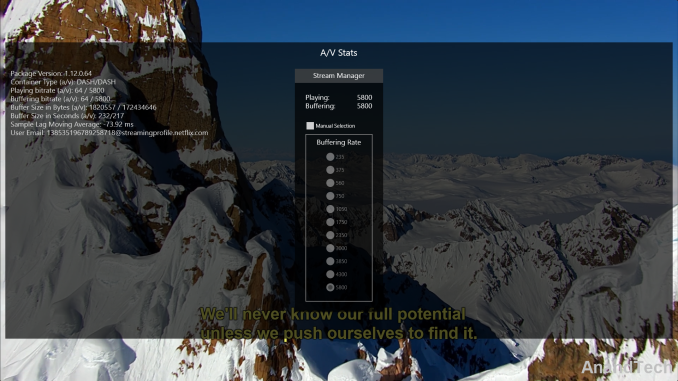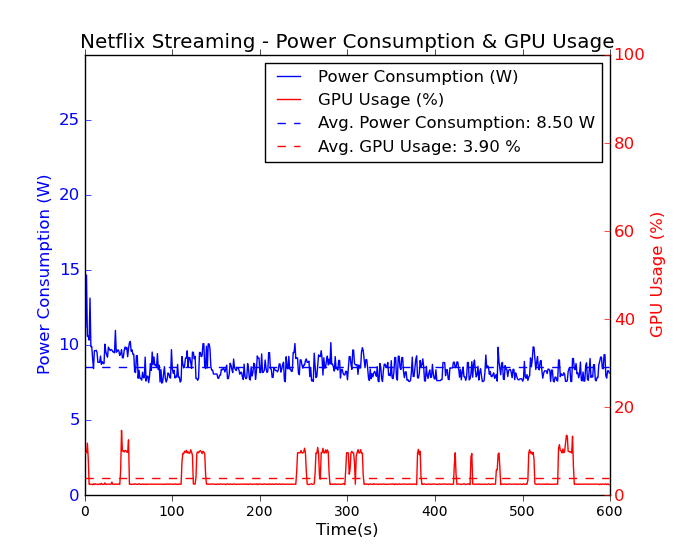Intel's Haswell NUC: D54250WYK UCFF PC Review
by Ganesh T S on January 3, 2014 4:25 PM ESTNetworking Performance and Streaming Aspects
In this section, we will take a look at the networking capabilities of the unit and also our standard HTPC streaming tests (involving YouTube and Netflix). Starting with this review, we are standardizing our evaluation of the wireless networking capabilities of UCFF and industrial PCs. Our standard test router is the Netgear R7000 Nighthawk configured with both 2.4 GHz and 5 GHz networks. The router is placed approximately 20 ft. away, separated by a drywall (as in typical US buildings). A wired client (Zotac ID89-Plus) is connected to the R7000 and serves as one endpoint for jPerf evaluation. The UCFF PC is made to connect to the two wireless SSIDs and jPerf tests are conducted for both TCP and UDP transfers with pre-set transfer parameters.
In our NUC build, Intel's Dual-Band Wireless-7260 delivers 2T2R 802.11ac speeds and provides very good throughput numbers when used with an appropriate router. As the gallery below shows, the 2.4 GHz band is able to deliver TCP throughput in the region of 86 Mbps and UDP throughput in the region of 96 Mbps.
The theoretical bandwidth number for 2x2 802.11ac is 867 Mbps. Practically, in the 5 GHz band, the 7260's TCP throughput is around 210 Mbps and UDP throughput is around 239 Mbps in our test setup.
Network Streaming Performance - Netflix and YouTube
YouTube and Netflix are two very popular streaming services utilized on HTPCs. With Windows 8, Silverlight is no longer necessary for Netflix streaming. The Netflix app on Windows 8 supports high definition streams (up to 5.8 Mbps) as well as 5.1-channel Dolby Digital Plus audio on selected titles.
It is not immediately evident whether GPU acceleration is available or not from the OSD messages. However, GPU-Z reported an average GPU utilization of 4% throughout the time that the Netflix app was playing back video. The average power consumption was around 8.5 W. Coming it at less than 10 W for the whole system while streaming HD video is very impressive. The spikes in the GPU usage were observed whenever the subtitles or control OSD kicked in. There is obviously some correlation between these spikes and the recorder power consumption at the wall.
One of the issues that I faced with the Netflix app was that bitstreaming HD audio (Dolby Digital Plus) would just not work. The playback was jerky to the point of being unwatchable and with either no or intermittent audio output to the AV receiver. Apparently, this is an issue faced by multiple users, and the problem stems from the Intel Display Audio Driver. Intel's rep on the forums, however, has been unable to reproduce the issue. So, it looks like many users are being left high and dry, unable to take advantage of one of the most important aspects of running Netflix as a Metro app.
Unlike Silverlight, Adobe Flash continues to maintain some relevance right now. YouTube continues to use Adobe Flash to serve FLV (at SD resolutions) and MP4 (at both SD and HD resolutions) streams. YouTube's debug OSD indicates whether hardware acceleration is being used or not.
Despite Windows 8 having plenty of YouTube apps, the browser interface is pretty much functional and free of external intrusive ads. The graph below shows the power consumption and GPU loading when playing a YouTube video in full screen using the Adobe Flash plugin on Mozilla Firefox.
The average GPU load is pretty constant around 8%, but power consumption at the wall has spikes corresponding to bursts of network activity. These bursts die down towards the end, after the full video gets buffered.
We saw that Haswell provided great power benefits for such network streaming activities in our HTPC piece at launch time. The Intel NUC takes this power benefit one step further by using a ULV processor. With a power consumption of less than 10 W for these activities, we are approaching dedicated media streamers' territory with the added flexibility of a full-blown PC at one's disposal.




















107 Comments
View All Comments
bigdang - Saturday, January 4, 2014 - link
Which devices are not being recognized? I had some devices not recognized on my box, but I was able to clear those up by downloading drivers from the NUC product support page. I downloaded the Management Engine Driver, the Nuvotron Driver, and (IIRC) the Gigabit Ethernet controller driver.quillaja - Saturday, January 4, 2014 - link
Device manager lists them as "PCI Simple Communications Controller", "SM Bus Controller", and "Unknown device". I strongly suspect the "unknown device" is the IR receiver (Nuvotron). I guessed I could probably get drivers for these devices from Intel's support page, but since not having them hasn't really affected the operation of my PC, I never bothered. I just dislike knowing that things aren't "perfect".jhoff80 - Saturday, January 4, 2014 - link
The first two happen on any Intel-based PC, not just this one. It's the Intel management stuff.Lundmark - Friday, January 3, 2014 - link
Thanks for the review. I'm getting a new HTPC any day now. Should I get the NUC or a Mac mini?I like Macs better and I know it will work with my TV's remote control, since it supports Apple remotes. But, apparently, there are issues with 24p both on Intel HD 4000 (which is off by 00,003 fps and thus shouldn't matter?) and OS X, which outputs exactly 24 fps and not 23,976. This causes judder, even if Plex/XBMC is set to match video speed to refresh rate. Apparently, you can fix this with SwitchResX, but it's a hack. I would probably run Windows on the Mac anyway for HD audio support. How serious is the Intel HD 4000 24p "bug", really? 00,003 frames sounds like nothing.
I'm also interested in what type of IR commands the NUC supports. With the Mac, I know what I'm getting and that it works, but I have no experience with the NUC. Incidentally, I need to find out if the NUC can be made to listen to any of the IR codes in my TV's database. My TV has IR blasters and downloads IR codes from the web, but that requires that the right codes are in the database. If the NUC can listen to an Apple remote, then I know it will work.
What do you think?
DigitalFreak - Friday, January 3, 2014 - link
The HDMI full range problem you mentioned appears to be fixed if you do a registry edit.http://www.avsforum.com/t/1477460/theory-about-int...
Alketi - Saturday, January 4, 2014 - link
It's also fixed in the latest OpenELEC nightly builds, if you're considering this as a dedicated HTPC running XBMC.JDG1980 - Friday, January 3, 2014 - link
I lost interest in this review when I realized that the system didn't have Iris Pro. Why is Intel so stingy in parceling out this SKU? Are they having yield problems? At this point, for all intents and purposes, it appears to be a rMBP-only part. I did a Google search for the Gigabyte BRIX that's supposed to have Iris Pro, but found only announcement articles - no reviews and no sellers. Has that been released yet?I really don't get Intel's strategy with Iris Pro. It's almost like they don't want it to succeed.
ganeshts - Friday, January 3, 2014 - link
I have a review unit in hand :) Review coming up after CES, may do a quick rundown before that...elian123 - Saturday, January 4, 2014 - link
Great! Really looking forward to that as I'm very interested in the Brix Pro.I hope in the review you can shed some light on the performance at 60Hz over displayport on UHD displays such as the Asus PQ321QE.
Jeffrey Bosboom - Saturday, January 4, 2014 - link
I'm also looking forward to the Brix Pro review, but please do some gaming tests in addition to the HTPC stuff. I'm curious how an Iris Pro part compares to a hypothetical Steam box with AMD's integrated graphics or a low-end discrete card. (I'm guessing it'll be thermally-limited, though I don't know what the Brix Pro's cooling is like.)